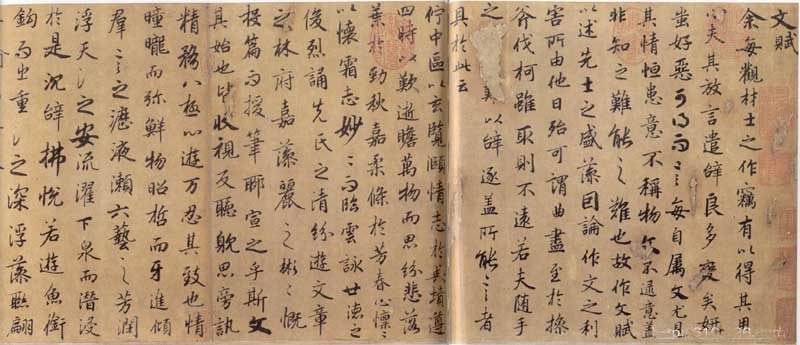Lu Jianzhi, whose birth and death dates are unknown, was born in Wu County (now Wuxian County, Suzhou). When the official came to the court, he was dismissed as an official and guarded the crown prince Si Yilang. He was active in the early Tang Dynasty. When he was young, he learned calligraphy from his uncle, who was Yu Shinan, a very famous calligrapher at that time. There are very few handed down works of Lu and Cambodia. "Jiangtie" contains 25 characters of Lu's book. The only other one is "Lu Jiwen's Fu of Lu and Cambodia's Book", which is known as Erlu Wenfu.
"Wen Fu" is an ink copy, one of the few original works by famous writers in the early Tang Dynasty. It is said that when Lu Jianzhi read Lu Ji's "Wen Fu" when he was young, he was so enamored with it that he wanted to write an article himself. However, he was afraid that his poor calligraphy skills would "tarnish" the masterpieces of previous sages, so he never dared to write rashly until his later years when the book became famous. Only then did I write this long-cherished wish. The writing style of this post is as good as that of a king, and it has won the charm of Jin people. Jie Xisi, a calligrapher of the Yuan Dynasty, once commented on this post and said: "You Lu Jianzhi's running script "Wen Fu" is a volume. The Tang Dynasty's calligraphy is strong and strong and has the style of the Jin people. This volume is the only one seen. Although it is like the Sui monk Zhiyong. , I still hate that there is too much charm and too much neatness. I sighed three times for this volume alone." Zhao Mengfu of the Yuan Dynasty rated it even higher, saying: "In the early Tang Dynasty, those who were good at calligraphy were called Ou Yu, Chu Xue, and when talking about calligraphy, how could they be inferior to the four sons? Yes. However, there are few traces of it in the world, so those who know it are grateful." (See the postscript of Zhao Mengfu's "Wen Fu")
Appreciate the ink in "Wen Fu", the brushwork is clear, elegant and smooth, and it indeed has the peaceful and simple artistic conception of "Orchid Pavilion". This post is placed between the waves and the waves, so that when it is turning, the body will be taken care of, which is all in line with the wonderful method of "Lanting". From this we can see the profound efforts Lu Jianzhi put into "Lanting". It should be pointed out that none of Wang Xizhi's extant Dharma books are authentic and most of them are copies made by people in the Tang Dynasty. As a copy, the difference in appearance may not be big, but in terms of the spirit and brilliance of the work, it cannot compare with "Wen Fu" and "Orchid Pavilion". Therefore, those who later studied Wang's calligraphy cherished this post particularly. Zhao Mengfu of the Yuan Dynasty once studied this post and understood the Jin people's brushwork and structure from it, and the benefit was obvious.
By the way, I would like to point out that this post occasionally has cursive writing mixed in with the running script, which feels incongruous. It may be an attempt by Lu Jianzhi. And precisely because "Wen Fu" is too similar to the King's Book, its artistic personality is not strong. The original work of "Wen Fu" entered the imperial palace during the Qing Dynasty and was later hidden in the Palace Museum in Beijing. Now in the National Palace Museum, Taiwan, my country.









